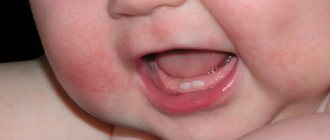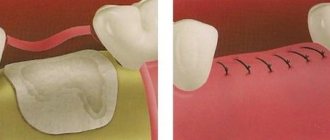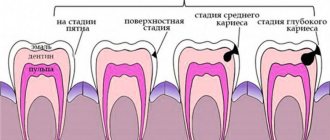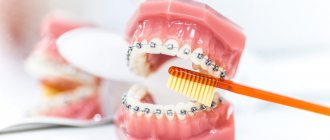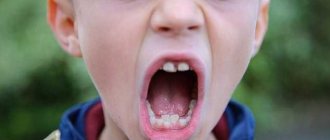Timing of eruption
Human chewing surfaces are formed during the period of intrauterine development. The rudiments of primary incisors and premolars are formed in the fourth month in the womb, and molars - in the fifth. Most children are born without teeth. They are not adapted to chewing food. The desire and ability to chew and bite appear later (closer to the first incisors).
The eruption of a child’s first incisors can begin at different ages. So, for most children, the first tooth appears at 5-6 months, for some - later, at the age of about 8 months, and for some - earlier, at 4 or 5 months of life. The norm is the appearance of the first incisor before the age of 1 year. Moreover, late eruption (at 10 or 11 months) is often explained by heredity. And in 1 out of 2000 cases, a child is born with teeth.
It has been noted that earlier eruption of incisors is characteristic of girls, and later eruption of incisors is characteristic of boys. This is due to the accelerated development of girls compared to boys. Therefore, their chewing surfaces appear a little earlier.
The order of teething in children
We talked about what time teeth come in, now we’ll figure out the order in which they erupt. So, when do canines, molars (molars) and incisors ?
Timing of baby teeth eruption in children, table
Let us consider the above table of dental growth in children in more detail. The table contains information not only about the timing, but also about the sequence of teething in children. It is important to emphasize that this information about the order of eruption of baby teeth is for reference only.
This means that parents should not panic or worry if their baby's teething order does not match the information presented in the table. The appearance of teeth, like other moments in childhood development, for example, the basic parameters of height and weight, are purely individual.
Therefore, there is no point in comparing the order in which your baby’s teeth or the neighbor’s toddler’s teeth grew. So, what is the order in which baby teeth erupt? And also which teeth erupt first and at what age? The diagram proposed above will help answer these questions and tell you how teeth grow in children.
However, first, let's understand the terminology. The table provides information about how baby teeth grow and which first appear. Milk teeth are the original “set of teeth” in humans and, interestingly, in other mammals too.
Yes, we are not mistaken, our pets cats and dogs and many other animals also lose their milk teeth, and in their place second, permanent ones grow. Based on the pattern of the appearance of the first teeth, it is clearly visible that the teeth on each half of the jaw, having the same name, for example, upper and lower incisors or canines, emerge simultaneously, i.e. in pairs.
Typically, the two central incisors of the mandible erupt first. We can consider these to be the first teeth that appear in babies at 3 months or later. Then, based on the schedule of teething in children proposed above and taking into account the principle of pairing, the central incisors in the upper part of the jaw emerge.
After them comes the time for the second incisors, only the lateral ones. They can appear either from above or from below, this is individual. It is considered normal for children under one year of age to have a full set of incisors, i.e. Both the upper and lower teeth come out.
The order of eruption of molars in children
Logically, the incisors should be followed canines or “eye” teeth. However, the process of teething in children begins only after the molars . In the meantime, so-called “tooth spaces” form in place of the fangs.
So, after all four incisors, molars appear - the first upper molars and the second lower molars. And only after all the molars take their places, the fangs emerge, which, by the way, are the strongest and most durable teeth.
How long does it take for upper and lower baby teeth to erupt?
It is considered normal that by the age of three, the number of canines and molars is equal, and their total number reaches 20 pieces. However, let us repeat once again, these are averaged data and in each specific case the process of eruption occurs at its own individual speed.
You shouldn’t even try to speed it up, since the body itself “controls” the situation, which means teeth will appear when needed.
Teething of upper teeth, photo
The central incisors (lower, upper) appear first in the interval from 3-6 months to 10-12 months. Lateral upper and lower incisors - from 7-9 months to 16-13 months.
The first upper molars are cut from 12-13 months to 18-19 months, the second lower and upper molars - from 20-25 months to 31-33 months. And the last lower and upper canines - from 16 months to 22-23 months.
Changing teeth, i.e. The loss of milk and the appearance of permanent ones in their place also occurs purely individually.
However, on average, the first teeth begin to fall out at the age of 6-7 years, and permanent teeth are fully formed by 10-12 years. The incisors are the first to change, and the canines and molars appear last.
Where does the first tooth grow?
As a rule, the first tooth grows in the bottom row. This is the lower front incisor. Often the incisors come out in pairs - one tooth appears, and after a few days the second tooth appears. However, this is not a mandatory rule.
Also, the upper incisors or the lateral incisors adjacent to them may appear first (as a rule, such an unconventional order of eruption is formed due to heredity).
How many first teeth are there? More often than not, the first tooth comes out alone. The second tooth may appear almost immediately (in a few days), or it may delay for 1-2 weeks. For some time, there has been asymmetry in the baby’s mouth (the first tooth came out earlier and is larger than the second). But the order in which the incisors appear does not affect the quality of their enamel or hardness. After some time, the sizes level out, the incisors become the same.
The first tooth is the body’s signal that it is time to introduce new food (solar foods).
After the appearance of the first incisors on the lower jaw, the anterior incisors on the upper jaw appear within a month. The baby becomes toothy. It can bite very hard on two opposite rows of incisors and molars (this often happens if the mother is distracted by conversations with other family members or on the phone while feeding the baby).
After 4 front incisors, the lateral incisors (second from the middle of the mouth) erupt in the child’s mouth. Most children develop a full set of incisors by the age of one year.
Next, the chewing surfaces are cut. Skip the fangs, which still remain in the gums, so-called premolars appear on the lower and upper jaws. At the age of one and a half years, 4 premolars emerge.
After them, 4 canines appear in the “holes”, and after that 4 more premolars. Thus, by the age of 3 years, a child has grown 20 milk teeth. Each jaw has 4 incisors, 4 chewing premolars and 2 canines.
Immediately after eruption, the teeth are located tightly and close. Later they find themselves at some distance from each other (depending on the growth of the jaw). At the age of 5-6 years, small gaps form between the child’s molars.
Specifics of the appearance of milk jugs
The eruption of milk ducts in children is a complex and deep mechanism inherent in genes, and preparation for this event is carried out in the child’s body almost from the moment of its birth in the mother’s womb. It is reliably known that baby teeth begin to form in the baby’s gums already in the second month of his life, and therefore any deviations already at this stage can play a negative role in the future.
Dairy teeth begin to erupt, on average, at the age of six months, although the first signs of the appearance of future teeth are sometimes noted as early as the fourth month after birth (in the form of small tubercles on the gums). The process of teething lasts until almost three years, and after another three years their gradual loss begins, with simultaneous replacement with permanent teeth that will remain with the person for the rest of his life.
Milk jugs begin to erupt, on average, at the age of six months,
The life cycle of milkmen is a very important and integral part of the formation of a child, therefore any deviation in the order determined by genes can lead to negative consequences that can affect other areas of the child’s body.
Doctors more often encounter children with premature loss of baby teeth, but from time to time the opposite situations arise when milkmen, for some reason, are in no hurry to teethe. In order to be able to objectively assess possible irregularities in the appearance of milk jugs, you need to check the long-established, well-known formula that describes this process:
- central incisors appear at 6–10 (bottom) and 8–12 (top) months;
- lateral incisors appear at 10–16 (bottom) and 9–13 (top) months;
- fangs appear at 17–23 (bottom) and 16–22 (top) months;
- premolars appear at 14–18 (bottom) and 13–19 (top) months;
- molars appear at 23–31 (bottom) and 25–33 (top) months.
Signs of teething
Signs of the eruption of the first incisors can be painful and unpleasant, or they can be subtle. Let us list what may accompany the appearance of the first incisor:
- Salivation.
- Swelling of the gums (mild or severe).
- Sore gums (the baby may cry from unsuccessfully squeezing a toy with his gums).
- Itching on the gums - is expressed in the fact that the child puts everything into his mouth, tries to “taste” everything on the tooth.
- Symptoms of inflammation and intoxication (fever, diarrhea, runny nose, throat cough) are also possible. Teething is stressful for the child’s body, so it sheds excess “ballast” and gets rid of existing toxins.
The first tooth is an unpredictable phenomenon
All parents, without exception, barely noticing the first tooth in their child’s mouth, overjoyed, certainly take their child to the pediatrician - doctor, help so that the baby doesn’t feel pain, and so that the teeth grow overnight, lining up in a beautiful “Hollywood” row.
Alas, neither pediatricians nor even pediatric dentists, by and large, can influence the teeth in any way during the period while they emerge from the gums and become part of the dentition. In modern medicine, which seems to be already capable of growing any organ in any place, there are absolutely no ways to influence the growth of teeth.
The first thing parents of infants should understand is that if someone is trying to force you on some miraculous drops, ointments, powders or pills that supposedly will make your baby’s first teeth grow quickly and without pain, don’t believe them. There have never been any means in medicine that can turn your baby into a saber-toothed tiger and there still aren’t to this day.
The child’s first milk teeth will erupt in due time and will come out as long and as painfully as nature intended. Moreover, this process occurs in all children individually. Some children experience absolutely no discomfort from the appearance of funny “stone” bumps in their mouths, while others, on the contrary, experience constant, aching pain, small spikes in temperature, loss of appetite and sleep.
Finally, the child begins to put everything he can reach into his mouth, because his swollen gums itch and itch unbearably. Here it is, it has begun! The first tooth has gone! And here many compassionate parents make two common mistakes, one of which often turns into a real tragedy.
Problems
Sometimes the front incisors and premolars come out without painful symptoms. In 35% of teething, a fever or runny nose appears.
It’s interesting to know: more often than others, symptoms of intoxication develop in artificially-bred children who receive formula milk instead of mother’s milk. With artificial nutrition, toxic substances accumulate in the child’s body. When teething occurs, toxins are released into the blood. Therefore, a runny nose, diarrhea, and fever develop.
Signs of future chewing surfaces appear one to two months before their eruption. Sometimes this process is delayed, the child experiences pain as early as 2 months, and the tooth appears only at the age of one year. But this is rare. More often, increased salivation is observed within 2 months before the appearance of the apex of the tooth.
Which first tooth comes out first in a baby: the upper or lower ones come out in babies?
Every mother eagerly awaits the moment when her baby’s first teeth grow. In a newborn, this process can begin at different times. There are babies whose gums swell at 2 months, and at 4 months they already have primary incisors. It’s worth knowing which teeth a child’s teeth come in first, and how many of them a child should have by the age of one or two years, in order to avoid any unpleasant moments later.
Teething
Symptoms of teething
When the teeth begin to grow, the child’s mood and activity change: the baby is very capricious, demands attention, cries and gets tired quickly. Pain and general malaise cannot even remove favorite toys, no matter how many attempts the mother makes to distract the baby.
The following symptoms are observed:
- The baby is reluctant to eat, refuses food completely;
- Sleep becomes restless;
- The baby constantly requires attention, “hangs” on the chest;
- The consistency of the stool changes: constipation or diarrhea, the baby defecates more often;
- There is a runny nose, cough, rash on the cheeks and around the mouth;
- The baby spits up frequently;
- A fever may develop, but the temperature should not be higher than 38.5 degrees.
Additional Information. As children's teeth grow, their immunity is reduced, so it is possible to catch an infection or cold. If your baby's temperature remains high for a long time (more than three days), he coughs a lot, and grabs his ears, you should go to a visit to the pediatrician to make sure there are no viral diseases.
Processes in the oral cavity
When a child’s long-awaited first tooth comes in, you can immediately notice:
- Swelling of the gums is observed;
- The baby drools and hypersalivation may occur.
Swollen gums during teething
Additional Information. Not all babies can calmly open their mouths for parents to notice teething and resort to first aid. You can offer your baby a breast or a bottle, rub rodents and teethers - this way the pain will subside a little, and you will be able to see the oral cavity.
Growth and its sequence
How long does it take for infants to erupt their first teeth?
While studying the issue of the appearance of baby teeth, dentists established a certain sequence, which is considered to be the norm.
Note! It is impossible not to pay attention to the formation of the dentition.
What appears first
According to the classical scheme, the lower incisors grow first, then the first upper teeth of the child are visible. Doctors believe it is correct for the teeth to grow first from the bottom, and then from the top. If this sequence is disrupted, then in exceptional cases this may indicate rickets in the baby.
Diagram of the dentition
Note! Sometimes the baby’s left and right canines, above or below, erupt first. The order of growth of permanent teeth is usually similar to the eruption of baby teeth. For kids, this moment is very individual.
The appearance of central incisors is usually the most painless, which is not accompanied by high fever and rhinitis.
Further cutting scheme:
- Upper lateral incisors, then lower ones;
- The first molars are on the upper jaw, later - on the lower jaw;
- Fangs above, below;
- At the end are the second molars (bottom, top).
Why do baby teeth come out differently for each baby?
- This is due to the characteristics of the baby’s growth and development;
- Due to hereditary factors;
- Depending on climatic conditions;
- Due to different types of feeding: breast, mixed and artificial.
Appearance time
How the upper teeth grow in babies - sequence
Which teeth emerge first in infants is an individual matter. Growth inside the gums begins from the first month. Often the incisor grows when the baby is already six months old, usually a pair of teeth at once.
Time of appearance of the first teeth
NameEruption time
| Lower central incisors | 6-10 months |
| Upper central incisors | 8-12 months |
| Upper lateral incisors | 9-13 months |
| Lower lateral incisors | 10-16 months |
| Upper small molars (molars) | 13-19 months |
| Lower small molars (molars) | 1.5 years |
| Upper canines | 15-22 months |
| Lower canines | 1.5-2 years |
| Lower large molars (molars) | 2-3 years |
| Upper large molars (molars) | 2-3 years |
Why don't teeth grow?
There are certain disorders due to which teeth are in no hurry to appear:
- Rickets in an infant;
- The baby has a problem with bowel movements;
- Some metabolic disorders;
- Adentia is a pathology when there are no rudiments of baby teeth;
- If endocrine disorders are present.
Note! Late appearance of incisors in 25% of children is possible due to some deviations and is associated with the individual characteristics of the child. If parents begin to worry very much, then it is worth seeking advice from a pediatrician and dentist.
Visit to the doctor
In the following situations, you should go to the dentist:
- Teeth appeared late or cannot erupt for a long time;
- Too early eruption;
- There is no tooth, a violation in the sequence and pattern of appearance;
- Incorrect formation of the crown, or the tooth has grown too far from the dentition;
The permanent tooth is not on the dentition
- A black edging is visible on the isthmus;
- The enamel became red, green, dark brown;
- The tooth is damaged.
Parents need to know what the first tooth comes out in a child, and how to accurately recognize this important process, to analyze the correct development of the baby. If you notice any deviations or complications, you need to promptly seek qualified help from a dentist.
Source: https://kpoxa.info/zdorovie-pitanie/kakie-zuby-lezut-pervymi.html
How to see?
Immediately after eruption, the tooth almost does not stick out from the gum. It has come out, but is not yet visible; it can be detected with a regular spoon. If you give your baby water or complementary foods from a spoon, you will definitely touch the gums and hear the characteristic “knock” of metal on bone tissue.
Interesting to know: teething can happen unnoticed. In such cases, parents suddenly notice an interesting quiet sound during feeding. Having looked closely, they find a tiny white spot on the surface of the gum - the tooth has already come out.
If the child is not yet given complementary foods, then it becomes possible to detect the first tooth a week after its appearance, when the top becomes clearly visible.
A tooth has erupted: what to do?
Eruption of incisors requires the development of new habits. What needs to be done when the first incisor has already come out:
- Give your baby new food (complementary foods).
- Give the baby the necessary load on the gums (solid food and chewing toys). Active chewing and biting is a massage of the gums. It accelerates blood flow and helps the next incisors or fangs to be born painlessly.
- Accustom your child to brushing his entire mouth (let him play with a toothbrush, set his own example).
What not to do:
- Giving your child a pacifier (this may interfere with the formation of a correct bite).
- Give sugar, sweets, and other confectionery sweets (they destroy bone tissue).
First tooth and complementary foods
The first tooth is the body’s signal that it is time to introduce new food (solar foods). Before the first incisor erupts, the introduction of complementary foods often causes dysbiosis, loose stools or other digestive problems. After the tooth comes out, the number of complications when introducing complementary foods decreases.
What should I feed my baby after the first baby incisor appears?
- The beginning of complementary feeding is kefir and grated fruit (apple or banana porridge).
- 1-2 weeks after the tooth comes out, add fresh cottage cheese + banana, apple to kefir.
- After another 1-2 weeks - a small amount of grains (porridge) + kefir + banana, apple.
After the first incisor appears, it is necessary to provide it with chewing load and give the baby solid food - an apple, carrot, bagel. At the same time, it is important not to leave the child alone with food, which he may bite off and choke on. An adult should supervise the process of introducing the baby to solid food.
